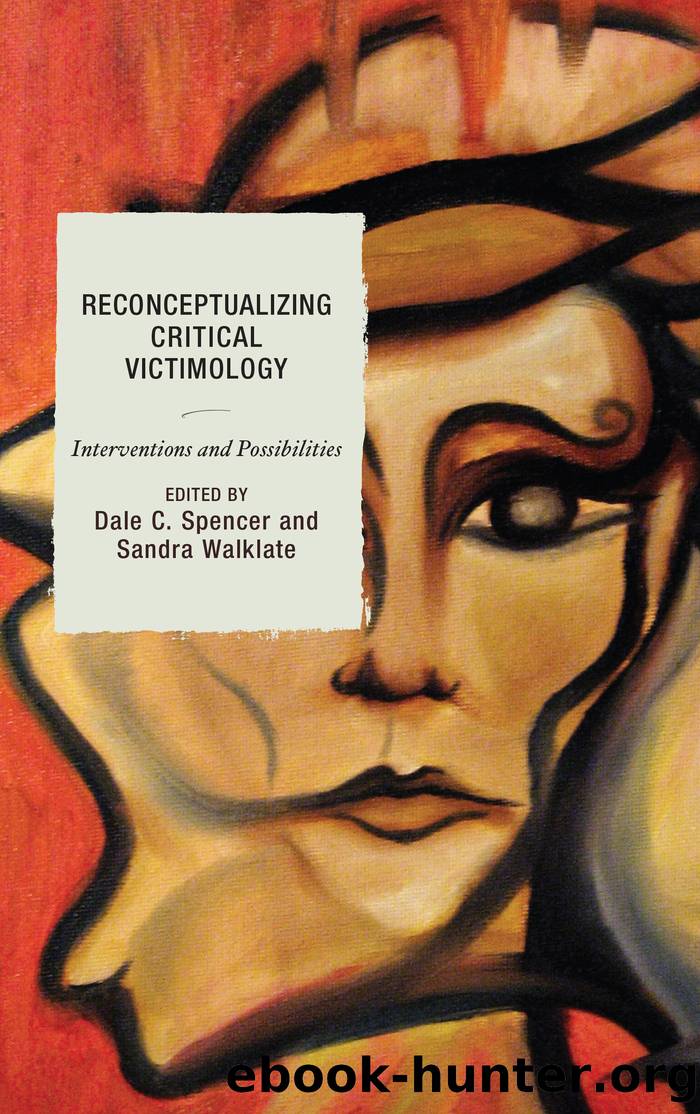Reconceptualizing Critical Victimology by unknow

Author:unknow
Language: eng
Format: epub
Tags: undefined
Publisher: Lexington Books/Fortress Academic
Published: 2012-08-15T00:00:00+00:00
Victimhood, Innocence, and Blame
There are innocent victims and there are terrorists and I find it offensive that anyone would seek to equate the two. People make choices to become involved in paramilitary groups and if they were killed, that was the choice they made. They didnât give their victims any such choice.[9]
The final issue we wish to address is the space available is the relationship between victimhood, innocence, and blame. We have argued previously that, like the construction of the crime victim in established democracies, a phenomenon is apparent in many of the transitional justice societies that we have studied wherein it is only those designated as âinnocentâ who may lay claim to the term victim (McEvoy and McConnachie 2012). Summarizing for current purposes, a hierarchy of victims is often apparent, where those who consider themselves or are considered by others to be âinnocentâ victims dispute the âdeservingnessâ of other âbadâ or âimpureâ victims (Madlingozi 2007; Meyers 2011) to recognition. Of course such victim hierarchies often map closely onto the national political sphere. As noted above, there are often close relationships between political constituencies and victimsâ groups, which may in turn be linked to disputed interpretations of the violence of the past and its justifiability.[10]
As we and others have argued, transitional justice appears to find it difficult to contend with victims who are not in fact entirely blameless (Bouris 2007; Moon 2008). Of course, in the lived experience of conflicted societies, not every victim will fit neatly into such boxes and, as argued above with regard to crime victims, individuals may move between these categories. By way of illustration, one of the authors has conducted interviews with hundreds of ex-combatants and, almost universally, they speak of experiences of victimhood in the form of violence visited against them, their families, or communities by other organizations, the state, or indeed the armed groups to which they belonged (Shirlow and McEvoy 2008). The two categories of perpetrators who are most readily recognized as victims in the transitional justice literatureâchild soldiers and female members of armed groupsâare again defined by the lack of voice or agency in their involvement in violence (Moser and McElwaine 2001; Drumbl 2012). Their claim to âinnocenceâ and their lack of agency is precisely what renders them eligible to the title of victim. For the rest of those directly involved in violence, they are usually deemed blameworthy. As the spokesperson for one reconciliation group in South Africa suggested:
I think thatâs the huge mistake that victims make, is that they donât ask themselves you know, a lot of deeper questions on, what would make somebody join a group of militants and to commit certain acts? What has shaped them to believe in what they do? . . . when people begin to reflect upon that they will be able to understand that as much as the victims have suffered but so too have people involved in the struggle gone through challenges and difficult things. They havenât just thought, OK, letâs go and attack that particular group of people, you know.
Download
This site does not store any files on its server. We only index and link to content provided by other sites. Please contact the content providers to delete copyright contents if any and email us, we'll remove relevant links or contents immediately.
ASTROPHYSICS FOR NON-MATHEMATICIANS by Unknown(284)
A Brief Introduction to Classical Mechanics with Illustrative Problems (181 Pages) by Shahen Hacyan(284)
Physics in Minutes by Giles Sparrow(274)
Understandable Statistics. Concepts and Methods by Charles Henry Brase Corrinne Pellillo Brase Jason Dolor James Seibert(249)
Modern Physics by Gary N. Felder and Kenny M. Felder(248)
Calculus - Single and Multivariable 6th ed. by D. Hughes-Hallett(247)
Fundamentals of Physics I by R. Shankar;(237)
A History of Mathematical Impossibility by Lützen Jesper;(230)
Meat Less: The Next Food Revolution by David Julian McClements(228)
Iraq at the Crossroads by Toby Dodge(220)
Probabilistic Risk Analysis and Bayesian Decision Theory by Marcel van Oijen & Mark Brewer(218)
Principles of Modern Chemistry by David W. Oxtoby H.P. Gillis & Laurie J. Butler(216)
Practical Math Success in 20 Minutes a Day by Mark A. McKibben(204)
A Mathematician Comes of Age by Krantz Steven G(204)
The Parrot in the Mirror by Antone Martinho-Truswell(203)
Sensory Ecology, Behaviour, and Evolution by Stevens Martin;(199)
Calculus, Early Transcendentals, International Metric Eighth Edition by James Stewart(193)
Chemistry for the IB Diploma Third edition by Christopher Talbot Chris Davison(188)
Understanding the Universe: From Quarks to the Cosmos (591 pages) by Don Lincoln(188)
